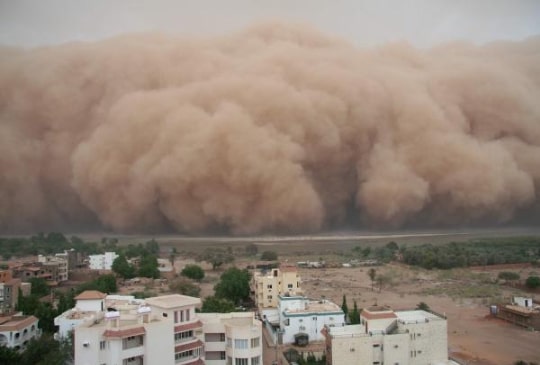Welcome to the Arta Mani Gostar WebSite.

Sand and dust storms usually occur when strong winds, values
Remove a lot of sand and dust from bare and dry soils. During one
Over the past decade, scientists have realized that its effects on climate are health
Man, the environment and many socio-economic sectors. WMO members in
Assess these impacts and develop products to guide preparedness policies;
Adaptation and reduction are at the forefront.
Sandstorms and dust are different meteorological hazards in the regions
Dry and semi-dry. They are usually caused by lightning storms – or slopes
High pressure associated with cyclones – are caused by increasing wind speed
They become a vast area. These strong winds are large amounts of sand and dust
From bare and dry soils to the atmosphere and hundreds to thousands
They move miles away. About 40% of airborne particles in the areas
Tropical (the lowest layer of the Earth’s atmosphere) dust particles caused by wind erosion
are. The main sources of this mineral dust are the arid regions of North Africa, quasi
The island of Saudi Arabia, Central Asia and China. By comparison, Australia,
The United States and South Africa have a small but important share. Global estimates
Dust emissions, which are mainly obtained from simulation models, are between one
It varies up to three gigatons per year.
After dropping from the surface, the dust particles are stirred by mixing and to
Convection updates increase to levels above the troposphere. They can
Can be lowered before being lowered again, depending on the size and
Meteorological conditions are transmitted using long winds. Since the
Larger particles precipitate faster than smaller particles, during transport
And there is a shift towards smaller particle sizes. Also dust with
Rain falls from the atmosphere. The average lifespan of dust particles in the atmosphere is several hours
For particles larger than 10 micrometers in diameter, for particles larger than micrometers
10 days are variable.
Interact with the weather and the weather
Particulate matter in the air especially mineral dust, climate as well as climate
Global and regional. Dust particles, especially if covered by pollution
Be, as condensate nuclei to form hot clouds and as the nucleation agent
Efficient ice cubes act to produce cold clouds. Ability of dust particles
Doing so depends on their size, shape and composition which in turn
It depends on the nature of the parent soils, propagation and transport processes.
Modify the microphysical composition of clouds, their ability to absorb solar radiation
Changes, which indirectly affect the energy reaching the earth’s surface
Put. Dust particles also affect the growth of cloud droplets and ice crystals
Therefore, it affects the amount and location of precipitation.
Airborne dust acts like a greenhouse:
It absorbs and scatters the sun’s rays that enter the Earth’s atmosphere,
Reduces the rate of reaching the surface and the long wave beams that reach the surface
It rises to the top, absorbs and spreads it again in all directions. Open
Also, the ability of dust particles to absorb the sun’s rays in size, shape and composition
Depends on their mineralogy and chemistry. Vertical distribution of dust in the air
(Vertical profile) and bottom surface characteristics are also required to quantify this impact
Is.
Its effects on human health
Dust in the air poses serious risks to human health.
Dust particle size is a major determinant of potential health risk
Is human. Particles larger than 10 micrometers are not breathable, so only
Can damage external organs – more irritating to skin and eyes,
Conjunctiva and hypersensitivity to eye infection. Inhaled particles, the ones
They are smaller than 10 micrometers, often in nasal congestion, mouth and device
Upper respiratory tract, so can with respiratory disorders such as
Asthma, trachea, pneumonia, allergic rhinitis and silicosis are associated. However
Fine particles may penetrate the lower respiratory tract and enter the bloodstream
Where they can affect all internal organs and be responsible
Be cardiovascular disease. Global model evaluation estimated in 2014
Exposure to dust particles causes about 400,000 premature deaths
Due to cardiopulmonary disease in more than 30 populations.
Depending on the weather and climate, dust may linger in the air for days, causing allergies to spread away from their source.
World Dust Map
Map of meningitis belt (red) and areas at risk of all diseases
Stuck (brown), in other areas may be less prevalent than
Have sporadic cases (source: World Health Organization) meningitis belt
(Red), high-risk areas (brown), all other possible areas of outbreaks and cases
Less scattered (Source: WHO)
Some infectious diseases can be transmitted by dust. Meningitis
Meningococcus is a bacterial infection of the thin tissue that surrounds the brain and spinal cord.
Can lead to brain damage and if left untreated, in 50%
Cases lead to death. It occurs worldwide, but most
Its incidence is penetrating